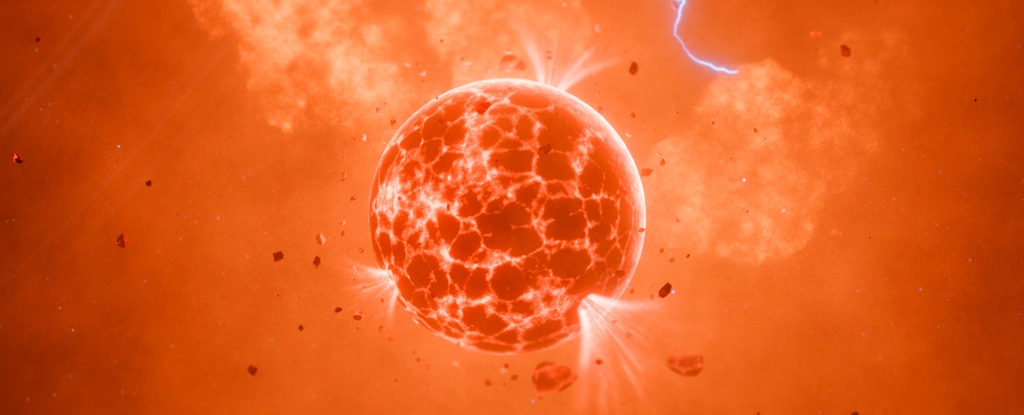Outside our solar system, there are many unknown worlds.
Recently, NASA’s Jet Propulsion Laboratory (JPL) spotted plumes of smoke around a gas planet outside the solar system called WASP-49 b.
Such plumes would come from a volcanic body, not from a gas giant.
So why was this phenomenon observed?
A clue may lie in Io, a moon in our solar system .
Io is known as a moon with many active volcanoes, and recently , a research team led by Mizuki Yoneda of Sanyo Gakuen University observed volcanic eruptions from Hawaii.
Plumes from a burning ‘volcanic moon’ discovered outside the solar system
There are many unknown worlds outside our solar system, and mysterious phenomena are often observed there.
In 2017, scientists confirmed the existence of a plume-like “sodium cloud” outside the solar system, far from Earth.
The location is near the exoplanet WASP – 49 b .
The exoplanet WASP-49 b is a gas giant about the size of Saturn, located 635 light years away from Earth.
Initially, the discovery baffled scientists.
These clouds are often seen when volcanic objects release gases, but WASP -49 b itself is a gas giant, making it unlikely to have volcanoes .
If WASP-49 b doesn’t produce the sodium cloud itself, something else must be creating it.
This has led scientists to speculate that there may be a moon with volcanoes similar to Io nearby, WASP-49 b.
By the way, Io is one of Jupiter ‘s moons and is known as a celestial body with active volcanoes that emit smoke .
Then , on October 10, 2024, NASA ‘s Jet Propulsion Laboratory (JPL) reported ( in a paper published on September 30) that it had discovered new evidence suggesting the existence of a moon of WASP-49 b .
They analyzed data collected over the past few years and uncovered new information about the sodium cloud.
The first piece of information is the amount of sodium in the cloud.
It was found that the sodium cloud was being produced at a rate of 100,000 kg per second .
This is far more sodium than is contained in WASP-49 b or its host star.
“That makes the case that something other than planets and stars is generating these clouds very plausible,” the JPL researchers said.
The second piece of information is the orbit of the sodium cloud.
The new observations show that the sodium cloud is not always present, but appears and disappears, sometimes disappearing behind WASP-49 b and the star.
They also observed that the clouds were moving faster than the planet .
“This observation would be impossible unless the cloud was generated by another object moving faster than the planet,” the research team said.
Regarding the direction of the clouds, they also stated, “If the clouds were part of the planet’s atmosphere, they should be moving in the opposite direction to that observed.”
This new evidence suggests that WASP-49 b may have a moon with volcanoes, similar to Io.
In addition, the research team used a computer model to show that the movement of the clouds could be explained if a satellite were to orbit WASP-49 b every eight hours .
This satellite is thought to be about the same size as Earth’s Moon.
Direct detection and identification of exomoons is difficult with current technology.
However, the existence of a volcanic moon called Io in our solar system gives us greater confidence that a similar “moon of WASP-49 b” exists.
However, the team also predicts that the exomoon will eventually fall and disintegrate into WASP-49 b due to mass loss and orbital decay caused by volcanic activity.
What will happen to volcanic moons outside the solar system in the future?
Continued observations of the volcanic moon Io in our solar system may provide some clues.
In that sense, the recently reported observational results on Io are of great interest to us.
Volcanic eruptions observed on Io, a moon in the solar system
Just as the Earth has a moon called the Moon, Jupiter also has a moon called Io .
Io is roughly the same size as the Moon (approximately 3,600 km in diameter), but is known as the most volcanically active body in the solar system .
Io has over 400 volcanoes, and numerous craters and lava can be seen on its surface.
Some volcanoes emit plumes of sulfur, sulfur dioxide and sodium that reach heights of up to 500 km.
Although it is within the solar system, Io is extremely far from Earth, and so far only large 10-meter telescopes and probes that approach Jupiter have been used to observe Io’s volcanoes.
However, in October 2024, a research team led by Mizuki Yoneda of Sanyo Gakuen University reported that it was possible to observe Io and the surrounding areas of Jupiter using a small telescope just 10 cm in diameter installed on a mountain in Hawaii .
They discovered that Io experienced repeated volcanic eruptions over a two-year period between 2017 and 2019.
The observations also showed gases emanating from Io’s volcanoes leaking out and spreading around Jupiter , which is shown in a reconstruction.
In this way, “volcanic moons” in the solar system have attracted attention as intriguing entities.
And there are indeed volcanic moons in our solar system.

